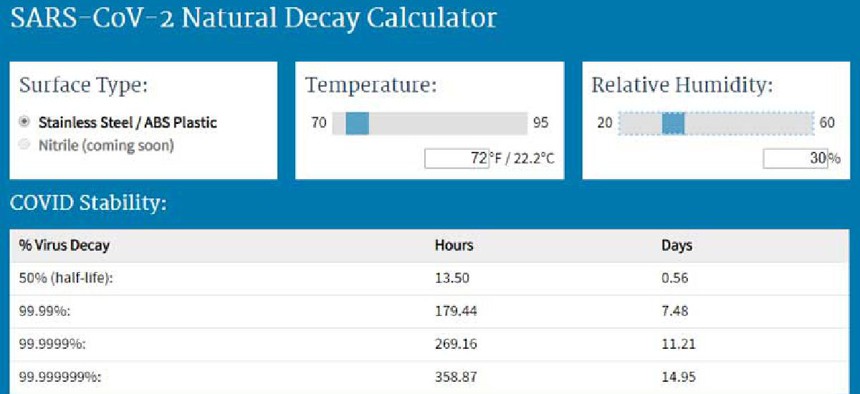Model predicts how long COVID lasts on surfaces

Department of Homeland Security’s Science and Technology Directorate has developed a predictive modeling tool that shows how fast SARS-CoV-2 will decay on hard surfaces under a range of temperature and humidity conditions.
To help estimate how long the COVID-19 virus remains stable on surfaces, the Department of Homeland Security’s Science and Technology Directorate has developed a predictive modeling tool that shows how fast SARS-CoV-2 will decay on hard surfaces under a range of temperature and humidity conditions.
“Transmission occurs primarily through respiratory droplets produced by talking, coughing, and sneezing. If these droplets settle on surfaces or objects, contact with those contaminated surfaces may also be a factor in spreading the virus,” said William N. Bryan, DHS' senior official performing the duties of the under secretary for science and technology, said in a statement.
Depending on temperature and relative humidity, the virus can survive in saliva droplets on surfaces for extended periods of time, S&T’s studies have shown. The initial version of the model displays the virus’ stability on stainless steel and plastic at temperatures ranging from 70 to 95 degrees Fahrenheit and relative humidity ranging from 20% to 60%. At 80 degrees and 50% humidity, for example, the model shows it can take nearly five days for the virus to degrade by 99.99%.
DHS officials said the model will continue to be enhanced as S&T produces additional data for virus stability in different environments – such as droplets in the air vs. on a surface, expanded temperature and humidity ranges and different surfaces, such as nitrile, the polymer used for rubber gloves.
As helpful as the tool is, S&T spelled out a number of caveats: The size of an infectious dose is unknown, as is how much of the virus an infected person puts into the environment and how much is transmitted by touching a contaminated surface. The model does not include the effects of conditions such as exposure to solar light.
S&T is partnering with DHS’ Countering Weapons of Mass Destruction Office to develop an easily accessible tool that could be used by occupational safety and health professionals for risk assessment and to comply with cleaning and disinfection in accordance with guidance provided by the Centers for Disease Control and Prevention and the Environmental Protection Agency.





